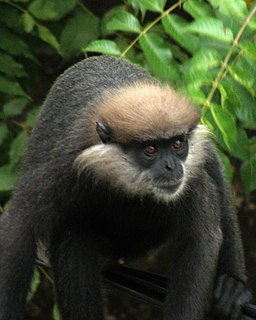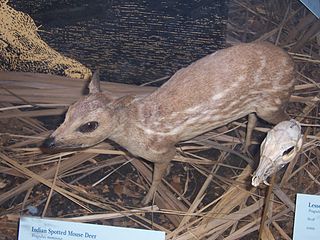
The rusty-spotted cat is one of the cat family's smallest members, of which historical records are known only from India and Sri Lanka. In 2012, it was also recorded in the western Terai of Nepal. Since 2016, the global wild population is listed as Near Threatened on the IUCN Red List as it is fragmented and affected by loss and destruction of prime habitat, deciduous forests.

The purple-faced langur, also known as the purple-faced leaf monkey, is a species of Old World monkey that is endemic to Sri Lanka. The animal is a long-tailed arboreal species, identified by a mostly brown appearance, dark face and a very shy nature. The species was once highly prevalent, found in suburban Colombo and the "wet zone" villages, but rapid urbanization has led to a significant decrease in the population level of the monkeys. Known as ශ්රී ලංකා(kalu Wadura) කලු වදුරා in Sinhala. It had traditionally been classified within the lutung genus Trachypithecus but was moved to the genus Semnopithecus based on DNA evidence indicating that is it more closely related to the gray langurs.

The Sri Lankan elephant is one of three recognised subspecies of the Asian elephant, and native to Sri Lanka. Since 1986, Elephas maximus has been listed as endangered by IUCN as the population has declined by at least 50% over the last three generations, estimated to be 60–75 years. The species is primarily threatened by habitat loss, degradation and fragmentation.

The Sri Lankan leopard is a leopard subspecies native to Sri Lanka that was first described in 1956 by the Sri Lankan zoologist Deraniyagala.

The golden palm civet is a palm civet endemic to Sri Lanka. It is listed as Vulnerable on the IUCN Red List. Its distribution is severely fragmented, and the extent and quality of its habitat in Sri Lanka's hill regions are declining.

The green-crowned warbler is a species of leaf warbler. It was formerly included in the "Old World warbler" assemblage.
Sinhalestes orientalis, the emerald Sri Lanka spreadwing, is a monotypic species of damselfly in the family Lestidae. The species was thought to be extinct since none have been found since it was first scientifically described in 1862. However, in 2012 this species was re-discovered by a young odonatologist Amila Sumanapala from the Peak Wilderness Sanctuary, Sri Lanka.

Crocidura hikmiya is a species of shrew described from the rainforests of Sri Lanka, based on both morphological and molecular data. Its closest sister species is the Sri Lankan long-tailed shrew, another Sri Lankan crocidurine shrew restricted to the high-elevation habitats of the Central Highlands. C. hikmiya has a shorter tail than the Sri Lankan long-tailed shrew; most of the other characteristics that distinguish the two species are osteological in nature .
Wildlife of Sri Lanka includes its flora and fauna and their natural habitats. Sri Lanka has one of the highest rates of biological endemism in the world.

Moschiola meminna is a species of even-toed ungulate in the chevrotain family (Tragulidae). Particularly in the old literature, M. meminna often refers to the spotted chevrotains as a whole. Today, the name is increasingly restricted to the Sri Lankan spotted chevrotain or white-spotted chevrotain, with the Indian spotted chevrotain M. indica and/or the yellow-striped chevrotain M. kathygre treated as distinct species.

Sri Lanka is home to 245 species of butterflies with 23 of these being endemic to the island. Of the 245 species, 76,
are listed as threatened nationally, while Ceylon Rose is designated as critically endangered.
Stiphodon martenstyni, the Martenstyn's stiphodon or Martenstyn's goby, is a species of amphidromous freshwater goby endemic to Sri Lanka where it can only be found in southwestern region. The males of this species can reach a length of 3.4 centimetres (1.3 in) SL.
Lipotriches notiomorpha is a species of bee in the genus Lipotriches, of the family Halictidae. It is endemic to Sri Lanka, where it was first found from Anuradhapura district.
Lipotriches bombayensis is a species of bee in the genus Lipotriches, of the family Halictidae.
Lipotriches torrida is a species of bee in the genus Lipotriches, of the family Halictidae.
Lasioglossum kandiense, also known as the Lasioglossum (Sudila) kandiense, is a species of bee in the family Halictidae.












